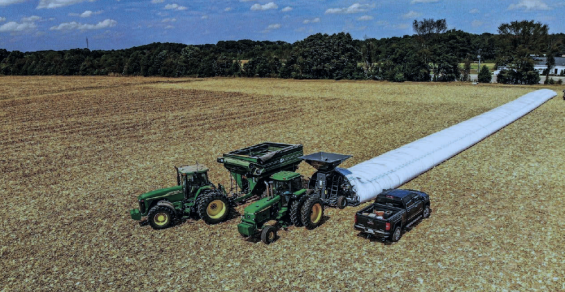While there are advantages and disadvantages to both, a new Grain Bag and Bin Storage Calculator can help producers find the best fit for their farm.
Storage is a powerful risk management tool for grain producers. Storage allows producers to reduce harvest delays, avoid seasonal price lows during harvest, expand their marketing window, and harvest grain at higher moisture – if drying or aeration is available.
There are two main options to store grain: grain bins and grain bags. Is one better than the other? What do prep and maintenance look like for each? And what are the operating costs?
Aaron Smith, associate professor of agricultural and resource economics at the University of Tennessee Institute of Agriculture sought to answer these questions through research. Smith discovered advantages and disadvantages to both, while also developing a Grain Bag and Bin Storage Calculator designed to assist producers in estimating the cost between the two storage options.
Grain Bags
Grain bags have recently grown in popularity among producers in Smith’s home state. Grain bags typically range in size from 10,000 to 18,000 bushels and allow for up to six months of storage. This allows producers to keep their combines working during harvest by reducing the hauling and unloading time at elevators. In addition, storage capacity can be rapidly adjusted based on the year’s production.
Grain bags can be filled at the edge of a field or in a centralized location. They’re typically filled in a straight line to make unloading easier and should be monitored for tears and damage to prevent insect and rodent damage to the grain inside.
Grain bag filling, monitoring, and unloading are all things to consider among other costs such as equipment and labor.
Grain Bins
Grain bins, on the other hand, can be constructed in a wide variety of sizes and configurations. This allows producers to hold grain safely for extended periods. However, grain bin construction can be capital-intensive and storage quantity is often fixed.
Each storage option has its advantages and disadvantages and is outlined below.
Grain Bag and Bin Storage Calculator
To aid producers in deciding between storage options, Smith and colleagues created a decision aid that allows producers to modify specific expenditure variables to obtain a total or per bushel cost estimate for each.
This calculator factors in machinery, equipment and other operating costs, and is available for download at utia.tennessee.edu.
Bag Advantages
Reduced harvest delays/lower transportation cost
Field’s edge storage
Adjustable storage amount
Loads and unloads faster than a grain bin
No fixed structure on the farm
Does not affect land taxes
Can change storage capacity rapidly
Bag Disadvantages
Cannot harvest at higher moisture levels
No drying capability or aeration
Possible wildlife and human damage
Loading/unloading can be difficult
Not suited for long-term storage in the Midsouth
Partial storage can be problematic
Bag disposal
Bin Advantages
Longer storage
Drying and aeration possible
Depreciable asset
Harvest at higher moisture levels/earlier harvest
Load and unload in multiple truckloads
Wider variety of grain storage
Not prone to as much human and animal damage
Bin Disadvantages
Fixed structure
More difficult to expand storage rapidly within a season
May affect land taxes
Higher upfront cost
May increase insurance
Slower load and unload times, compared to bags




